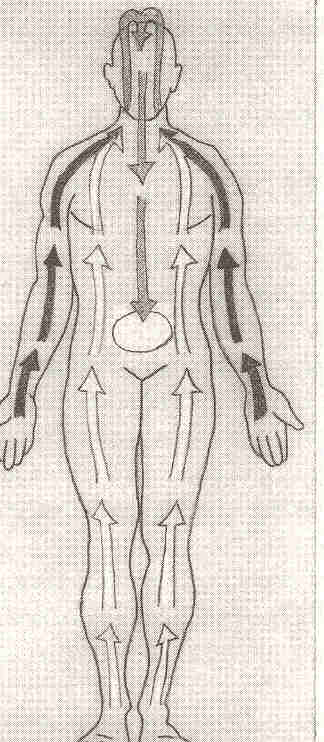| INERT-GAS VISUALIZATION TECHNIQUES | |
A
kinesthetic (tactile) visualization process will enhance inert-gas
therapy. Some
of the visualization exercises indicated below have been described in
Robert Bruce’s book “Astral Dynamics” (Part 2).
Basically, these exercises increase the etheric body’s capacity
to absorb inert-gas-associated subtle energies. When
you stimulate by a variety of visualizations the sensation of tingling,
tapping, warmth, or cool (i.e., the typical inert-gas sensations) in
various body points, you usually will be able to transfer the same sort
of energy into the spinal cord injury area. A
helpful visualization couples the breathing sensation with the sensation
of some pressure, tingling, or brushing on the skin taken more deeply
into the body. For example, on inhalation, sense the feet being brushed
by a paintbrush and, in turn, that sensation coming up the legs, up
through the trunk, moving up through the shoulder and head region, and
then back down, ending up in the area just below the naval. When
exhaling, visualize the reverse with the energy moving back up into the
head and shoulder and down and out the feet. Once
there is a tingling sensation, try to extend it, imagining what it would
feel like if it is a brushing, tingling, tapping, warmth, coolness, or
if it was extended further into areas of numbness, to move through the
border regions, to play with the idea of the sensation of the energy
itself, and then once you are more familiar with this sensation, to put
it into the spinal cord injury area. Increase the sensation by
visualizing the energy from the inert-gas device pouring through you,
enhancing the movement of these subtle energies. Again,
this is a kinesthetic visualization, in which the sensation is
provoked, sometimes by means unique to you, e.g., tapping with a
feather, brushing with a paintbrush, tapping lightly with the fingers,
and a very gentle, almost imperceptible squeezing action by the fingers
as in an extremely gentle brushing massage. There are many
possibilities. Sometimes, the process is best activated by actually
providing the paint If
you are visually predisposed, combine color visualizations with the
kinesthetic stimulation. It could be a white light pouring through the
body to purify and cleanse, a blue light to purify and calm the mind, a
yellow light in the heart to awaken and strengthen, and in the spine,
various other healing colors. (To determine if you are if you are
visually predisposed, someone can ask you to visualize a room, providing
a basic outline of what is in the room, and then ask you deeper
questions about it. If you can respond with details that are clearly
visually related, i.e., color, shape, form, size, etc., then include
visual elements.) This kinesthetic and visual coupling is often helpful. For example, on exhaling, visualize the skin pores opening adjacent to the spinal cord injury area. What is released is allowed. Thus, one recognizes the color. It may be brown or black as if a toxic smoke is being released. On inhalation, as the skin pores open in the injury area, other colors are recognized. For example, a healing blue, emerald energy, or clearing, strengthening, fusing yellow light may be perceived as entering the pores. Allow the colors to change as necessary. Similarly,
if you have an auditory predisposition, imagine various sounds,
even intoning pitches that seem to resonate internally with the affected
body area. For example, you may intone a particular chakra-associated
syllable or word. To
jumpstart the process, use recordings of sounds or, in the case of the
visually predisposed, light as used in light therapy. Later, however,
continue the visualization processes without such aids. Albeit
more difficult, smell or taste sensations also can be used. For
example, imagine the taste of foods that seem inherently strengthening
to you. Smell, such as with aromatherapy,
also can be a powerful modality.
|
|
 brush,
feather, squeezing sensations by fingers, etc. But as soon as possible,
any physical action should be stopped so that these processes can be
immediately coupled into the sense of kinesthetic visualization.
brush,
feather, squeezing sensations by fingers, etc. But as soon as possible,
any physical action should be stopped so that these processes can be
immediately coupled into the sense of kinesthetic visualization.